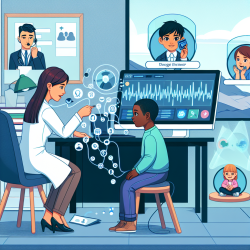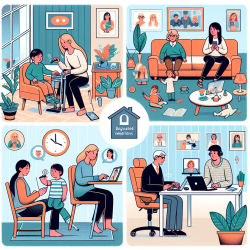As a practitioner dedicated to improving child outcomes, it is crucial to stay updated with the latest research and methodologies. One such innovative approach is the implementation of Routines-Based Home Visits (RBHVs) via telepractice. The research article "Supporting Families from a Distance: Implementing Routines-Based Home Visits via Telepractice" by Hinton et al. (2023) provides valuable insights into this method. This blog aims to distill key findings from the study and offer practical advice for enhancing your telepractice skills.
Understanding Routines-Based Home Visits (RBHVs)
RBHVs are a cornerstone of early intervention (EI) services, designed to improve the quality of life for families and achieve positive outcomes for children with disabilities. The Routines-Based Model emphasizes family-mediated interventions, where caregivers are empowered to create learning opportunities within their daily routines.
Why Telepractice?
Telepractice allows for the delivery of therapeutic services through internet-based technologies. This modality has proven especially useful during global crises like the COVID-19 pandemic, offering a flexible and accessible means of service delivery.
Implementing Tele-Routines-Based Home Visits (T-RBHVs)
To effectively implement T-RBHVs, practitioners should follow these steps:
- Videoconferencing with Screen Share: Use secure, HIPAA-compliant platforms like Zoom or Microsoft Teams. Screen sharing can facilitate interactive and visual consultations.
- Bug-in-Ear (BIE) Technology: Utilize BIE for real-time, discreet feedback during family consultations. This technology minimizes distractions and enhances the quality of parent-child interactions.
Challenges and Solutions
While telepractice offers numerous benefits, it also presents challenges such as technological accessibility and the need for rigorous testing of telepractice tools. Practitioners should aim to use well-tested technologies and provide training for both themselves and the families they serve.
Building Fidelity of T-RBHV Implementation
Fidelity checks are essential for ensuring that T-RBHVs are implemented as designed. Tools like the Routines-Based Home Visit Checklist and the Routines-Based Telepractice Visit Checklist can be used to gather fidelity data and provide performance-based feedback.
Recommendations
For effective T-RBHVs, consider the following:
- Utilize rigorously tested technologies.
- Follow established guidelines for RBHVs.
- Ensure equitable access to telepractice technologies for all families.
Telepractice in EI offers a promising avenue for overcoming barriers in service delivery. By incorporating these strategies, practitioners can enhance their telepractice skills and achieve better outcomes for the children and families they serve.
To read the original research paper, please follow this link: Supporting Families from a Distance: Implementing Routines-Based Home Visits via Telepractice.










